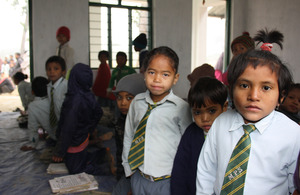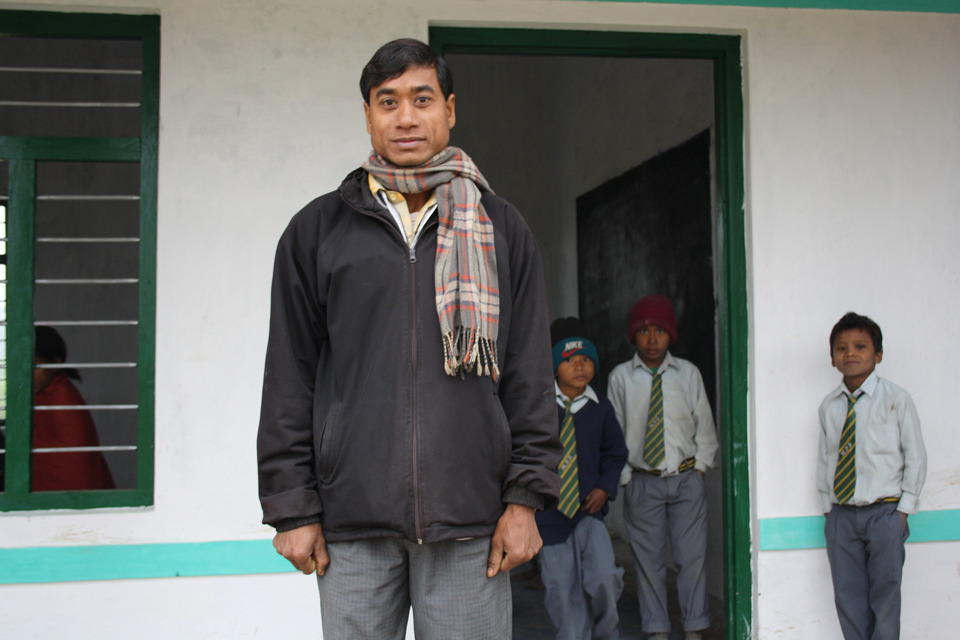Building safer, stronger schools in Nepal
Community support programme rebuilds and improves schools to help educate Nepal's next generation

Pupils at the Manakamana Primary School in Kailali, inside their new school building. Picture: Robert Stansfield/DFID
When an elephant destroyed their ramshackle school building, more than 100 children at the Manakamana Primary School in Kailali, Nepal, were left without a classroom. But thanks to support from UK aid from the Department for International Development, these students are now able to continue their education in a new building, built to withstand shocks more powerful than elephants.
Abhiral Chaudhari, 8, a pupil at the primary school said: “I did not go to school when we did not have a classroom. It was too far for me to go to the other school and I missed my friends. I really like our new building. It is safer than the old one and we all have somewhere to sit down. I am learning a lot and am much better with my words and numbers now.”
A safe environment to learn
Nepal is at the centre of one of the world’s most earthquake-prone regions with a very high risk of a devastating natural disaster. The new classrooms are specially designed to reduce the chance of a collapse during a quake – potentially saving the lives of the children inside.

Nokhiram Kumar, Headmaster at Manakaman Primary School in Kailali stands in front of the new school building. Picture: Robert Stansfield/DFID
Before the new school building was built, pupils at this remote school in the far west of Nepal either had lessons outside - sweltering in 40C summer temperatures and near-freezing winter conditions - or were forced to walk for an hour to the next nearest school. This journey also included a walk through a river as there is no bridge to get across.
The school building was constructed as part of the Community Support Programme, a project which has already improved school facilities for 2,800 communities. CSP often steps in with funds for school buildings since the government can be slow to respond to natural disasters.
Nokhiram Kumal, the Headmaster at the primary school said, “The original school building was very dangerous and not very well built. When it was damaged by the elephant, it was not safe to continue lessons inside. It was very difficult for the children to learn anything when we had no building. We tried to teach them outside but we had no facilities for them to use – no blackboard or furniture.”
“We are so grateful for the new building. We are already seeing big improvements in their reading and writing. They are learning so much more and are doing better in tests. Their parents are so happy as this will make such a difference to their children.”

Pupils at the Manakamana Primary School in Kailali pose in front of their new school building with their Headmaster. Picture: Robert Stansfield/DFID
The CSP, now in its tenth year, is bringing services to some of the world’s most remote communities. In addition to building schools, the project will train more than 1,000 poor youngsters to help them get a job.
The programme is also helping 1,500 families work themselves out of poverty with support to set up and develop their own businesses so they can afford to send their children to school and for those living beyond the reach of the government’s free healthcare programme, to pay for healthcare.
Facts and Stats
The Community Support Programme has improved school facilities for 2,800 communities – benefitting 600,000 families. More than 1,000 other community projects are being supported to benefit 116,000 households.
CSP has already allowed 91,000 households access clean drinking water.
More than 100,000 people are being trained to help their communities deal with the threat of disasters, including earthquakes.
CSP makes funds available direct to communities and helps them decide what to spend them on.